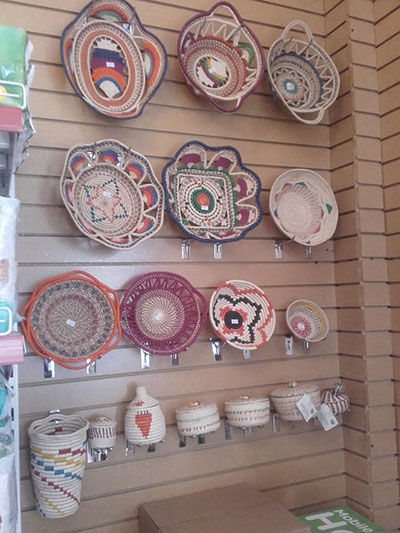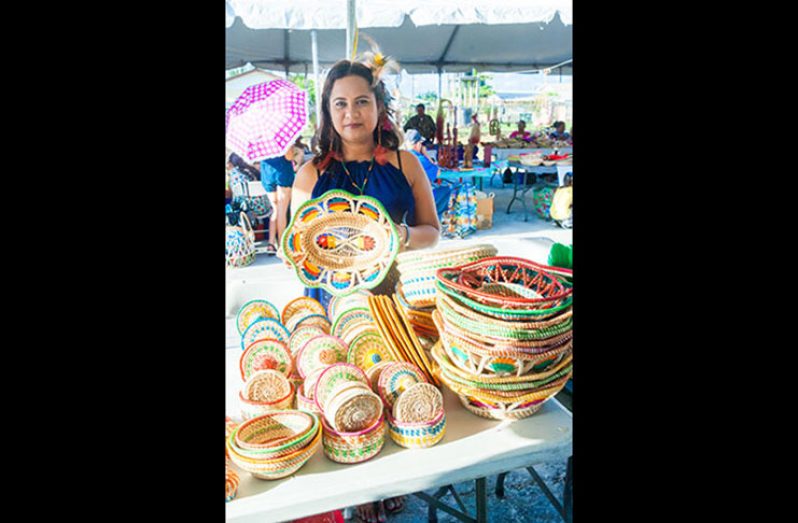by Gibron Rahim
WITH Indigenous Heritage Month upon us, the craftwork of Guyana’s first peoples come to the fore. Craftwork undeniably always catches the eye. The intricacy and beauty of craft pieces no doubt naturally sway you to buy them. It is unfortunate that, at the same time, the casual viewer is unaware of the amount of work that is put into these pieces. Indigenous artisans create their unique pieces in celebration of their heritage and to pave a

way forward for the future.
In the village of Moraikobai, Veronica Clinton continues the craftwork that she learned from her mother. She told the Pepperpot Magazine that her mother taught her that craftwork was a way of not only earning a livelihood and not having to depend on others but also as an activity to be done in her spare time. Before she dedicated more of her time to crafting she was a teacher. In fact, she found a way to implement craftwork into her students’ schoolwork. Eventually, though, she developed her own design motifs and started creating pieces such as baskets, handbags, hats and placemats, the technical knowledge of which she had gained from her mother and from workshops in which she had participated.
Clinton greatly enjoys being involved with her craftwork. She is just as passionate about teaching young people where they could benefit from a knowledge of the art of craft work in their spare time. She explained that though the earnings from the occupation are not huge sums, being involved in craftwork provides them an opportunity to entertain themselves in their spare time. Being able to teach and having her work appreciated is heartening to Clinton.
“It gives me more encouragement because to this day my craft goes on exhibition,” she said. The people in her community also express an interest in her work and from this, she is able to receive orders. From the responses she receives she still has “that ambition and that willing spirit to go ahead in doing craft.
The process of gathering the materials for crafting can prove difficult at times. Clinton uses tibisiri from the ité palm in all of her craftwork. Gathering requires going into the interior and finding the trees. Once found, the branches from the trees are cut. The distance that needs to be travelled to find the palms has greatly increased in modern times since the savannah land is being burned and cleared for farmland.
“Sometimes we go on the tractor and bring back like five or six bundles,” she said. Once the branches are gathered and taken home, the silk is stripped from them. The silk is then boiled and left to dry in the sun for three days. It is after this lengthy process that the actual crafting can begin.
The Pepperpot Magazine also spoke with Miranda Bernard of Pakuri Village, formerly St. Cuthbert’s Mission. Bernard was introduced to craftwork through her parents, Mark and Beryl Bernard. Bernard recently represented Guyana at CARIFESTA in Barbados as part of the Art and Craft Producers Association of Guyana and she proudly declared that all her pieces were sold out by the end of the event. She has also previously participated in the Business Expo, Guy Expo and last year’s Indigenous Food and Craft Exhibition.
Like Clinton, Bernard also works with tibisiri. The pieces she creates include fruit baskets, coasters, placemat sets, bowl sets, jewellery boxes, and floor and foot mats.
It is important to distinguish between the craft styles of different Indigenous groups. The type of craft produced depends on the tribe, as Clinton explained. The people of Moraikobai and Pakuri are Arawaks. The craftwork in these villages is centred around tibisiri which they are experts on working with. “We do the craft in our culture, in our traditional way,” Clinton said. On the other hand, artisans from the Rupununi are mainly Makushi and Wapishana. Their craftwork is composed of nibbi and beadwork. Each distinct style is beautiful in its own right and reflects the heritage of the craftspeople.
Locating a market for their work can prove difficult. Clinton explained that the craftspeople are willing to produce once they are assured of a steady market for their work. Recently, she has been receiving help with marketing her craftwork. She carries her completed pieces with her whenever she makes the lengthy trip into Georgetown and leaves them with a marketer. Some of these pieces can be found at Venus The Beauty Planet on Parade Street. She also told the Pepperpot Magazine that she was making preparations to display her work at Moraikobai’s Heritage Day on September 16.
Bernard also spoke about the difficulty in finding a market for her products in Guyana. She opined that Guyanese were not as interested in Indigenous craftwork. This makes it difficult to justify investment in exhibiting locally. She has found greater success in making sales at exhibitions in Caribbean islands.
The ability to work with one’s hands is a wonderful skill, and sometimes it is underappreciated one. Indigenous craft are sometimes exquisite pieces that are also functional. The dedication to their craft that is evident in Clinton and Bernard illustrate that, with proper investment, Indigenous craftspeople can honour their individual heritages, while also being able to move forward into a hopeful future. That quality of keeping our roots planted firmly in the ground with our branches reaching toward the sky is one we can all benefit from.













